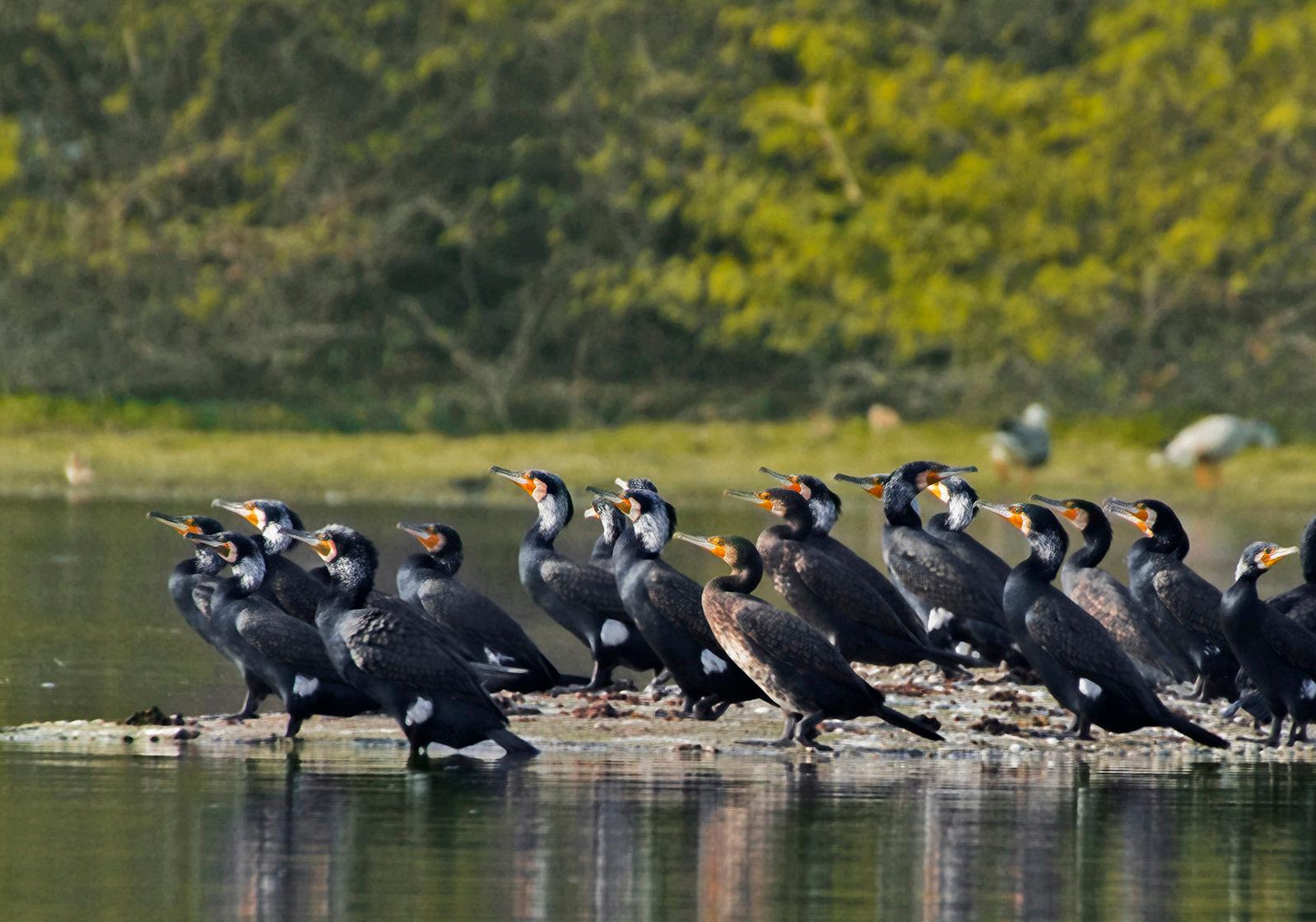
16 minute read
ECOTOURISM SPECTACLES IN THE HEARTLAND OF INDIA
India and its biodiversity have welcomed travelers and settlers as early as one can gleam through recorded history. India, the 7th largest country in the World, occupies 2.4% of World’s area and is also home to 17.7% of World’s population. Nature has bequeathed India with a rich biodiversity. Uttar Pradesh (UP), most populous State in India, is in the Northern Plains, and has been a cradle of cultural exchanges for centuries and birth place of many religions. UP occupies a major portion of the vast Indo-Gangetic plains and lies on the foothills of Himalayas. Primarily the climate is warm with three clearly distinct seasons – summer, winter and monsoon (rainy season). Archaeological finds indicate that Stone Age Homo Sapiens were residing in this area for the 85,000 years ago. Being such an old civilization, region saw a unique development of culture, languages, religions, architecture, literature, dance, drama and music.
UP has been bestowed with distinctive physiographic zones viz. Bhabhar1, Terai2, Indo-Gangetic Plain3 Vindhayan Region and Bundelkhand Region. Bhabhar region is dry and the water table is very deep while in Terai it is very moist, as the water table is near the surface and is covered by dense vegetation and supports a diversity of flora and fauna. Bhabhar and Terai tracts are interspersed by rivers, streams and rivulets all of which originate in the Himalayas and flow down in north-south direction. Snow fed rivers have water round the year while rest are seasonal. Gangetic Plains make up the largest part, has fertile soil and supports booming agrarian economy. Depressions on the surface make lakes and wetlands that are spread all over UP. Vindhyan Region is rocky with hilly terrain and plateau and have diverse scrub forests and some sal (Shorea robusta) forests. Agriculture is low yielding. Though water availability in this region is low but there are few dramatic waterfalls. Bundelkhand Region is also made up of rocky rugged terrain and has diverse mixed deciduous forests4
Recorded forest area5 in UP is 14,818 sq. km. which is 6.15% of the total geographical area. Forests are mostly in Bhabhar and Terai regions in the North, and in Vindhyan and Bundelkhand Region in the South. Indo-Gangetic Region has fairly degraded forests and plantations which also harbor fair amount of diverse wildlife. Wetlands support variety of aquatic animals and birds, both native and migratory. There are on record about 2,900 species of plants (6.34% of numbers in India) of which 10 species are endemic to UP and 53 species are listed as rare and threatened. UP has about 15% of the flowering plants found in India. Similarly, there are 2,540 species (2.94 % of numbers in India) in UP. Co-existence of such diversity with a large human and livestock population is possible due to deep rooted environment and biodiversity consciousness amongst people who live here. UP and for that matter India’s approach is to manage and conserve biodiversity in their natural habitat. UP has one National Park6 i.e. Dudhwa National Park which is also a Tiger Reserve7. Three other Tiger Reserves are Pilibhit, Amangarh and Ranipur. There are 26 Wildlife Sanctuaries8 and one Conservation Reserve9. Ten wetlands, part of Wildlife Sanctuaries, rich in native and migratory birds have been declared Ramsar Sites10 UP offers memorable ecotourism experiences coupled with cultural exploration and nature relaxation. Identifiable themes of ecotourism an be grouped in 4 categories.
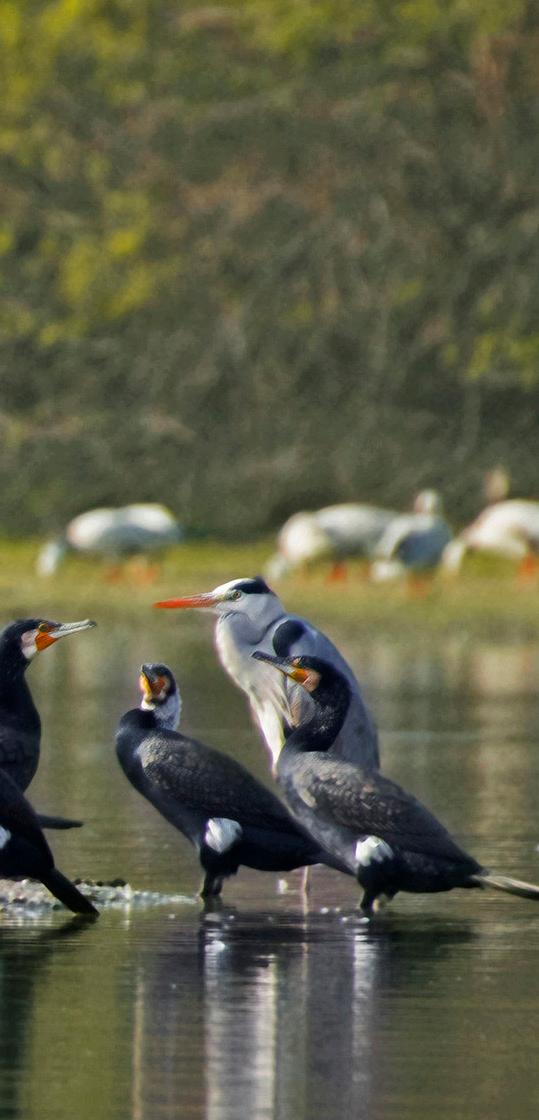
1. Terai Arc Landscape11 in North UP, encompassing Bhabhar and Terai landscapes, is dotted with dense forests, grasslands, and water bodies. This eco-circuit zone is a natural habitat for a wide variety of forest denizens including the Tharu tribe. Tharus occupying the buffer zone around the forests, their traditional homes are made of sustainable materials like mud, straw, and manure bestowing a cooling effect during summers. In this matriarchal society, women wear colorful attire, and heavy jewelry, and expertly weave dhurrie12 and baskets from local grass. While their main occupation is farming, they are skilled in the art of engaging with wild elephants (Elephas maximus indicus), making them the best mahouts13. Their folk music and dance traditions are also remarkable. Living at the forest margins has accorded them with knowledge of herbs and shrubs that have healing properties. Interestingly, due to living close to the swamps, Tharus are immune to mosquito-borne diseases like malaria. Their ethnomedicine tradition is a subject of medical research. Inquisitive travelers and health enthusiasts can gain an entry into the world of Tharu holistic nature-based healing at Tharu Van Nidhi, Forest Healing Shop located near Dudhwa National Park. The shop has extensive sustainably sourced lifestyle goods ranging from furniture, farm-to-table produce, handicrafts, and much more. One should try Tharu cuisine as it has distinctive earthy flavors. Tharu way of life is marked by an intimate relationship with the jungle, nudging the community to protect, conserve, and respect their local ecosystem.
Dudhwa National Park, Amangarh & Pilibhit Tiger Reserves; and Sohelwa, Katarniaghat & Sohagibarwa Wildlife Sanctuaries are natural habitats of tiger (Panthera tigris), elephant (Elephas maximus indicus), rhino (Rhinoceros unicornis), sloth bear (Melursus ursinus), swamp deer (Rucervus duvaucelii), hog deer (Axis porcinus), gharials / gavials (Gavialis gangeticus), magar (Crocodylus palustris), alongside a very large and varied avifauna that includes highly endangered Bengal Florican (Houbaropsis bengalensis). Dudhwa National Park is the only place in the world where 5 species of deer abound. The largest grasslands of northern India are also in this National Park, and are the places where One-horned Indian
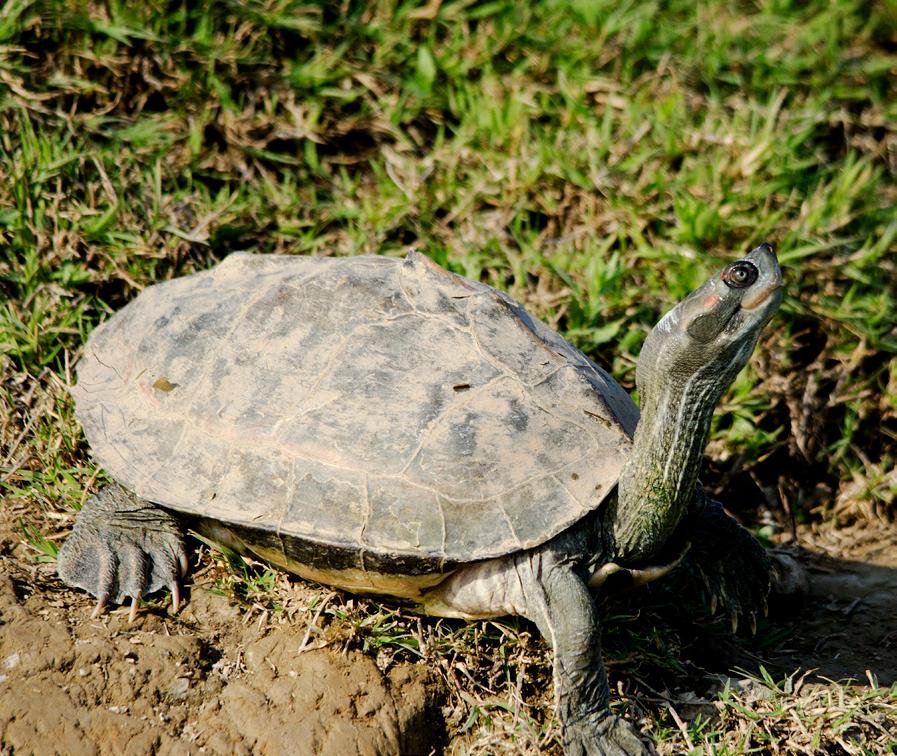
BHABHAR REGION IS DRY AND THE WATER TABLE IS VERY DEEP WHILE IN TERAI IT IS VERY MOIST, AS THE WATER TABLE IS NEAR THE SURFACE AND IS COVERED BY DENSE VEGETATION AND SUPPORTS A DIVERSITY OF FLORA AND FAUNA.
Rhinoceros (Rhinoceros unicornis) lives. These ancient animals were reintroduced in their erstwhile habitat in mid-seventies of the last century. The seed population of seven animals has now grown to more than forty. The grasslands of the National Park and Kishanpur Wildlife Sanctuary are home to highly endangered swamp deer (Rucervus duvaucelii), also known as barasingha or twelve-horned deer. Herds of these animals often exceeding 200 in numbers can be seen in the wetlands. One can encounter pythons, rat snakes, vine snakes, kraits monitor lizards and chameleons sun bathing themselves in winter. Sitting in the visitor accommodation or in the Forest Rest Houses, visitors can acquaint themselves with the sounds of the jungle that include the barking of the barking deer, roar of the tiger, hooting of owls, chirping of vast varieties of birds and alarm calls of monkeys making denizen of the jungle aware for the presence of a tiger. →
→ Pilibhit Tiger Reserve has almost assured tiger sighting in some stretches of the forest roads along with frequent sighting of sloth bear (Melursus ursinus) and herds of spotted deer. White pristine sandy beaches of the Chuka area remind one of the beaches of the vast coastline of India and global presence of white sand sea beaches.
Sandbars of Girwa river in Katarniaghat Wildlife Sanctuary offer wondrous sight of extremely large gharials / gavials (Gavialis gangeticus) and magars (Crocodylus palustris) basking in the warm sunlight during winter months. Interspersed with these basking giants are a variety of turtles and colorful birds. Ganges River Dolphin (Platanista gangetica), designated as India’s National Aquatic Animal, symbolizes the purity of the River in the area, as it can only survive in clean fresh water.
If one seeks to explore the Buddhist landmarks in Terai and Eastern UP then nearby Suhelwa Wildlife Sanctuary and Sohagibarwa Wildlife Sanctuary should not be missed. These are excellent bird-watching spots which along with natural walk trails make these wildlife areas relaxing places for weary travelers and devotees.
2. Indo-Gangetic Plain is dotted with water bodies and is all the year home to native birds and winter abode to migratory birds. About 1,300 species of birds have been recorded in the Indian subcontinent, out of these about 550 are found in UP. The multitude of wetlands that may or may not be designated as Bird Sanctuaries are wonderful places to view the multitude of migratory birds that come here in winter from the northern latitudes of Europe and Asia. Being part of the Central Asian Flyway, migratory birds visit the wetlands on their way to warmer climes during their migration from the northern latitudes with the onset of winter and again on the return journey to their breeding grounds in northern Europe and Siberia. Sarus Crane (Grus antigone), the tallest flying bird in the world with a height of about 1.50 meter and wing span of about 2.40 meter, is a resident of UP. It is seen in wetland almost across the length and breadth of UP and is accompanied by other resident birds that include open billed storks (Anastomus oscitans), cormorants (Phalacrocoracidae), spot-billed ducks (Anas poecilorhyncha), babblers, black, grey and swamp partridges (Francolinus gularis), egrets (Ardea alba), parakeets (Psittacula eupatria) etc. Beautiful birds like the Paradise Flycatcher (Terpsiphone), Verditer Flycatcher (Eumyias thalassinus), Jacobins Cuckoo (Clamator jacobinus), Indian Pitta (Pitta brachyura), Emerald Dove (Chalcophaps indica) etc. are summer visitors that can be seen in the woodlands and some wetlands. As a matter of fact, throughout the year birders can see some or the other wonders of the avian world in the woodlands and wetland across UP. Bird watching clubbed with butterfly watching is an excellent experience for a nature lover. There are close to 175 species on record including exceedingly small grass blues to the large Mormons, lime swallowtails and vividly colored Jezebels (Delias eucharis), Glassy Tiger (Parantica aglea), Black Rajah (Charaxes solon), Silverline (Spindasis vulcanus), Jays (Graphium agamemnon), Pierrots (Castalius rosimon) and Commander (Moduza procris). Soor Sarovar Bird Sanctuary (Agra), Haiderpur Bird Sanctuary (Muzaffarnagar) and Okhla Bird Sanctuary (Noida) are ideal places for bird watching. Soor Sarovar Bird Sanctuary has a well-equipped beer rescue facility which is home to bear rescued from captivity. This makes it a definite visit for those who are visiting Agra and / or Mathura.
National Chambal Sanctuary is a must visit destination for those who want to see gharials / gavials (Gavialis gangeticus) and magars (Crocodylus palustris), Gangetic dolphins (Platanista gangetica), a wide variety of turtles and flocks of Indian Skimmers (Rynchops albicollis) all in one place.
Indo-Gangetic Plain is the cradle of Indian Civilization having influenced by Hinduism, Buddhism, Jainism, Islam and Christianity. History and culture dates back to ancient times, beliefs are carried forward from one generation to another with changes adopted to meet requirements of present times. Landscape is dotted with historical buildings, forts and palaces, religious places, monuments and shrines. Depiction of plants and animals on these structures, ancient to present ones, can be seen everywhere.
ABOUT 1,300 SPECIES OF BIRDS HAVE BEEN RECORDED IN THE INDIAN SUBCONTINENT, OUT OF THESE ABOUT 550 ARE FOUND IN UP. THE MULTITUDE OF WETLANDS THAT MAY OR MAY NOT BE DESIGNATED AS BIRD SANCTUARIES ARE WONDERFUL PLACES TO VIEW THE MULTITUDE OF MIGRATORY BIRDS THAT COME HERE IN WINTER FROM THE NORTHERN LATITUDES OF EUROPE AND ASIA.
Other wildlife areas of interest are Hastinapur Wildlife Sanctuary (Meerut) which runs captivity breeding of gharials / gavials (Gavialis gangeticus) and tortoises (Testudinidae) for their release in rivers. Etawah Lion Safari should not be missed, it houses Lion Breeding Centre which is an essential component of ex-situ conservation program for lions in India. Other Bird Sanctuaries in this region are Parvati Arga (Gonda), Sandi (Hardoi), Lakh-Bahosi (Kannauj), Nawabganj (Unnao), Bakhira (Sant Kabir Nagar), Surha Taal (Ballia), etc.
3. Vindhayan Region is dotted with low hills, mesmerizing waterfalls, sal forests and mixed deciduous forests. Sonbhadra district nestled between Kaimur and Vindhya hills is said to be the Switzerland of the East. Caves abounding river valleys were occupied by prehistoric humans with some sites having cave paintings. Salkhan has fossils dating back to 1.4 billion years representing Ectasian period which was part of the Mesoproterozoic era.
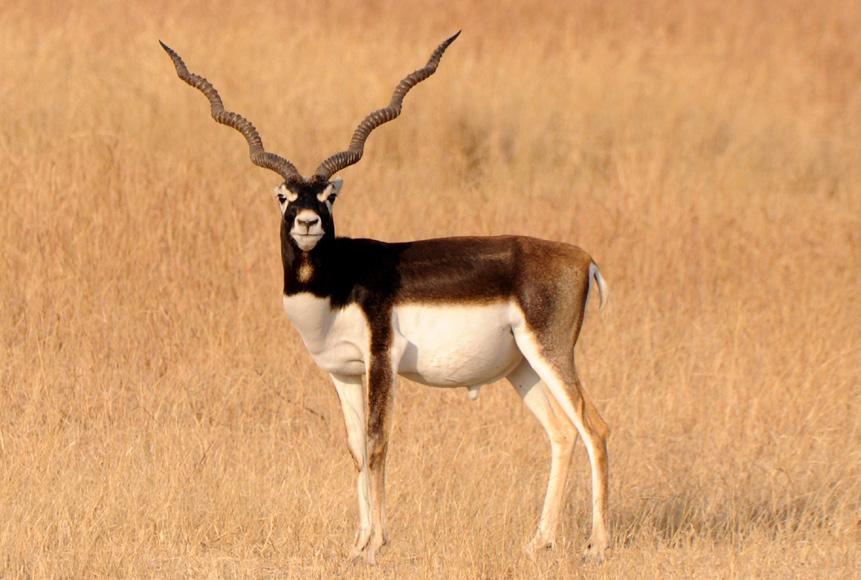
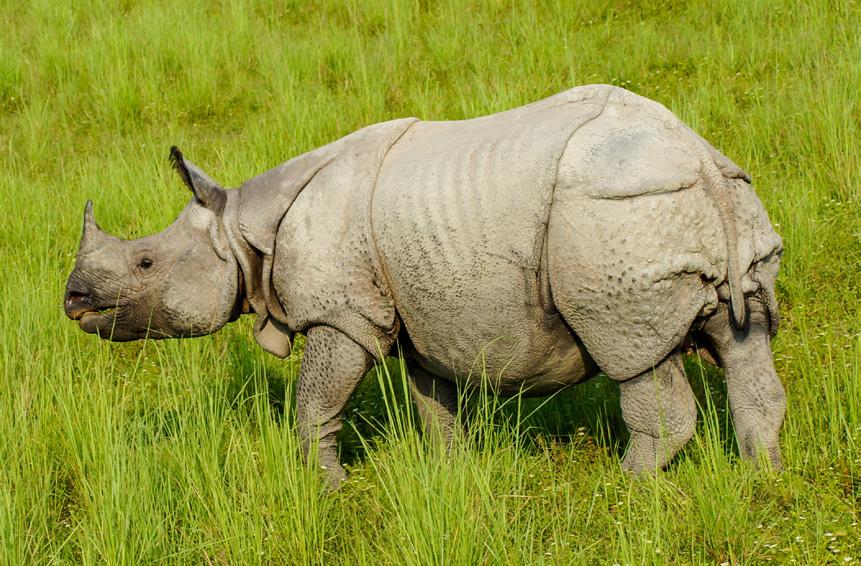
Fossils are spread over an area of 25 hectares. This area is being pitched by the State of UP for inclusion in the list of UNESCO World Heritage Sites.
Rocky landscape of Chandraprabha Wildlife Sanctuary harbors many unique plants that have immense medicinal value. One can experience blackbucks (Antilope cervicapra), Chital (Axis axis), Sambar (Rusa unicolor), nilgai (Boselaphus tragocamelus), wild boar (Sus scrofa), bear (Melursus ursinus), and many other animals in their natural habitat. Evidences of presence of prehistoric humans can be seen in primitive paintings on cave walls. One can also witness the culture of indigenous tribes like Baiga, Gond, and Chero who live within these forests. Numerous waterfalls embellish the landscape. Rajdari and Devdari waterfalls are located inside Chandraprabha Wildlife Sanctuary. Other beautiful waterfalls are Siddhnath Dari, Lakhaniya Dari, Chuna Dari, Mukha Falls, Kushiyara Falls, Tanda Falls, Wyndham Falls and Sirsi Falls. Rajdari and Devdari are at their best during monsoon months (July to September).
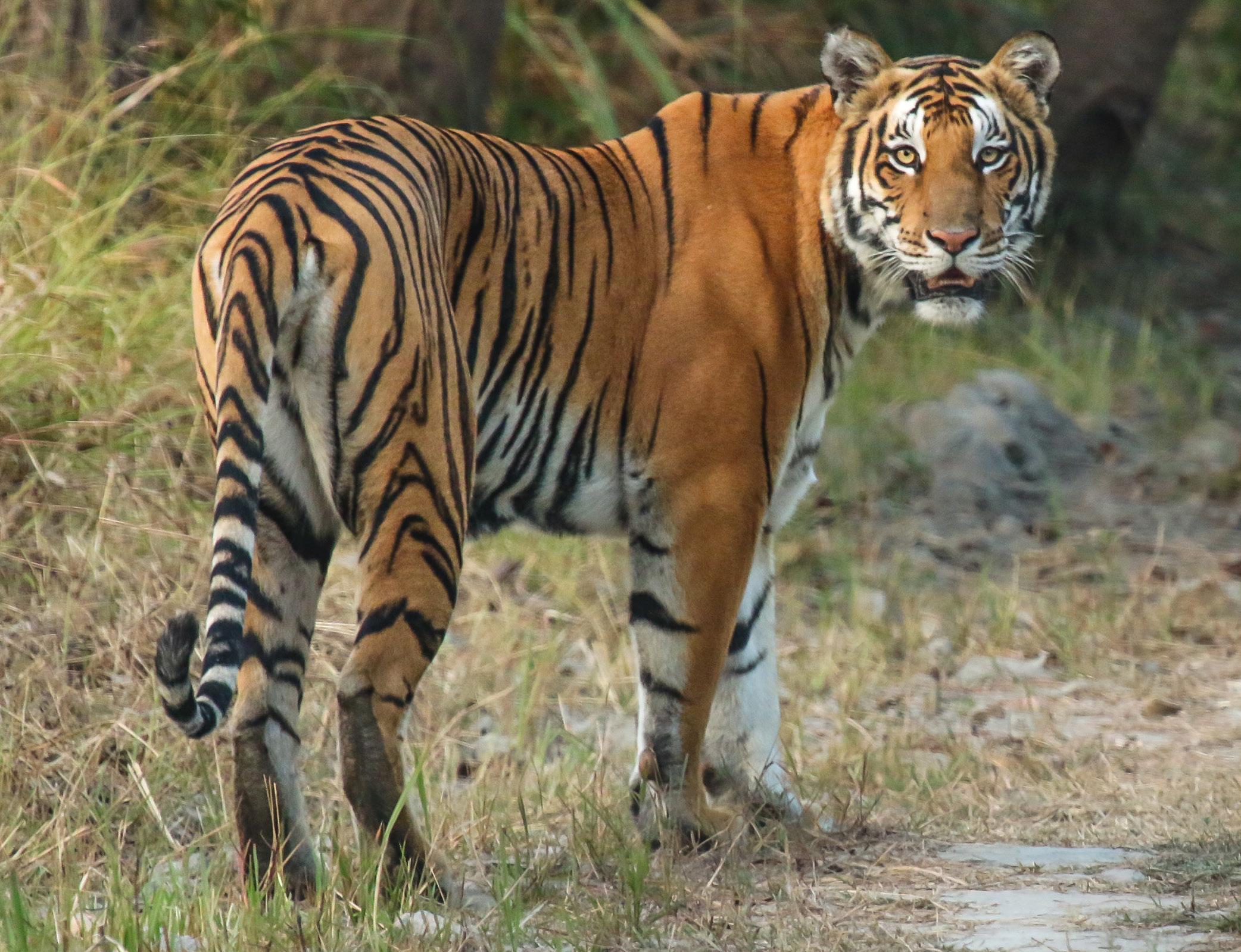
Kaimur Wildlife Sanctuary spreading over parts of Mirzapur and Sonbhadra offers a completely different canvas. Open forests and rocky expanses interspersed with clumps of xerophytic plants and grasses is home to Black Buck (Antilope cervicapra). Herds of these majestic creatures can be seen grazing or crossing the landscapes with their unique gait which is a mesmerizing mix of leaps and trots. The sight of clashing males during their mating ritual is a unique experience. This area is famous for rock paintings of the upper Paleolithic Period or Old Stone Age (from approximately 3.3 million years to 11,700 BC.). Landscapes of Mirzapur, Chandauli and Sonbhadra lying in the Vindhyan Region take on a unique shade of reddish-orange in the months of March and April when dhak (Butea monosperma), also known as “flame of the forest” comes to bloom. Chand Khamaria Black Buck
Conservation Reserve in Prayagraj is a unique example of community driven conservation efforts and should be visited those who intend to visit Prayagraj as tourists or pilgrims.
4. Bundelkhand Region is marked by rocky mineral-rich hills interspersed by tributaries of Yamuna. Vijay Sagar Bird Sanctuary (Mahoba) surrounds the lake built during medieval times. One can enjoy bird watching, nature gazing, and water sports within its vicinity. At Mahavir Swami Wildlife Sanctuary (Lalitpur) wildlife enthusiasts can spectate animals like leopards (Panthera pardus fusca), nilgai (Boselaphus tragocamelus), wild boar (Sus scrofa), sambar (Rusa unicolor), black buck (Antilope cervicapra), endangered vultures and much more. Mauranipur in Jhansi has a vulture colony in caves and cavities in low hills. Ranipur Tiger Reserve (Chitrakoot) is contiguous with the forest of Panna Tiger Reserve and tigers can be s ighted in this Tiger Reserve. →
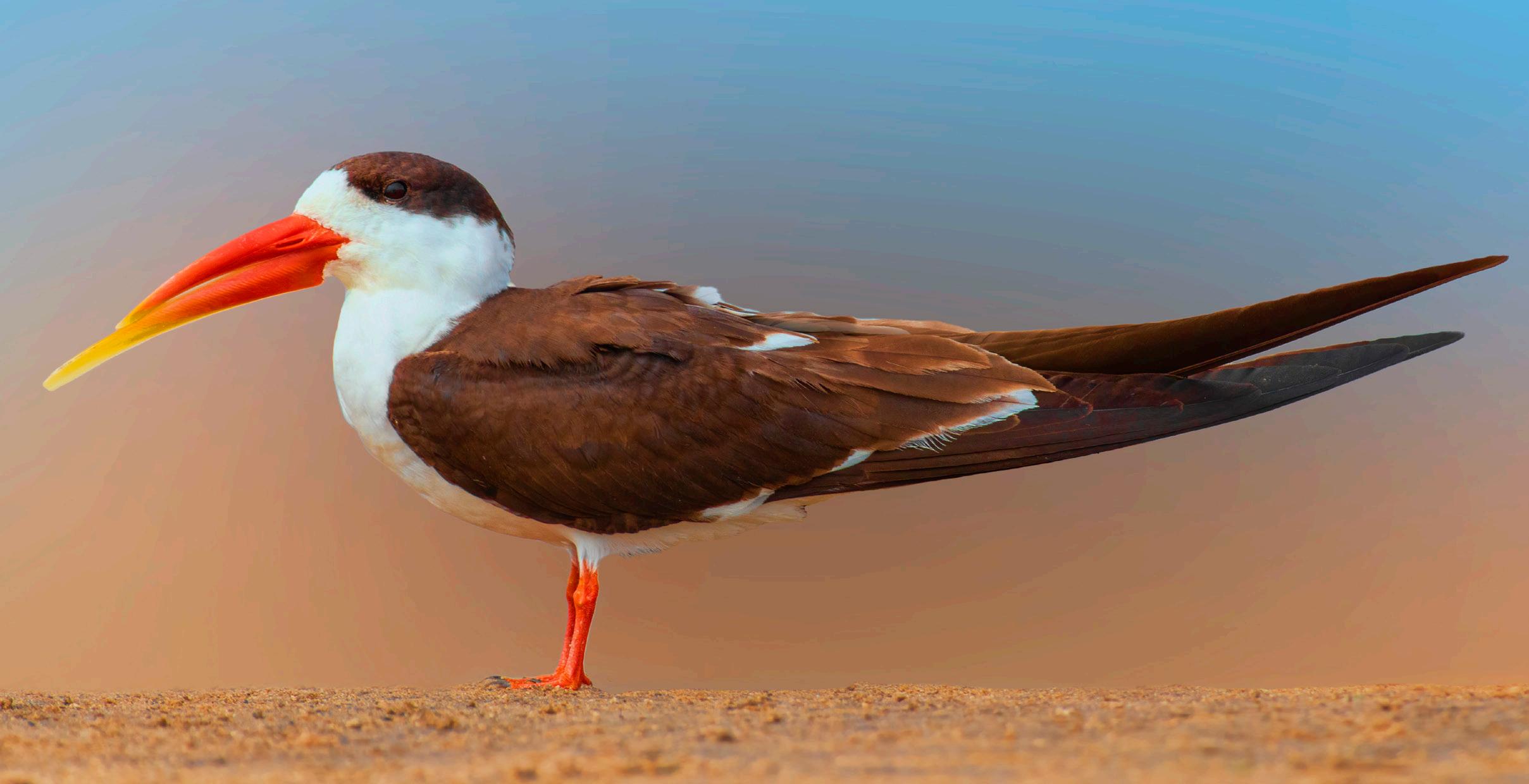
→ Bundelkhand region is revered among Hindus and Jains and have numerous temples. This area is rich in culture and an important place in India’s history right from medieval times to present day. It is believed that Lord Ram and Sita spent their exile in the forests of Chitrakoot with the important sites being conserved and revered by devotees. Dashavatara Temple in Deogarh (Lalitpur) is the oldest Nagara style temple. Deogarh also boasts of an expansive Jain temple complex consisting of numerous stylistically adorned temples built during the medieval period. Remnants of Chandela and Maratha regional supremacy can be experienced in the forts that abound with green scenes. Kalinjar Fort (Banda) has a long history of political occupancy from ancient times to colonial period. Situated atop the Vindhyan hills, overlooking the Bundelkhand plains this picturesque fort encloses temples and caves. The flagbearer of Bundelkhand’s valor is Rani Laxmi Bai, queen of Jhansi who was martyred at the age of 22 in order to save her kingdom and people from foreign rule.
IN PURSUING
ECOTOURISM AS THE PREFERRED TOURISM MODEL, GOVERNMENT OF UTTAR PRADESH IS COMMITTED TO TAKE ITS DEVELOPMENT TO NEW HEIGHTS AND BALANCE THE TRIPLE BOTTOM LINE VIZ. PEOPLE, PLANET, AND PROSPERITY. UP STATE ECOTOURISM DEVELOPMENT BOARD (UPETDB) IS ENTRUSTED WITH THE MANDATE TO PROMOTE ECOTOURISM IN THE STATE AND TO PROVIDE UNIQUE ECO-EXPERIENCES TO VISITORS.
India has a robust policy and regulatory framework for protecting natural ecosystems, forests, wildlife and indigenous communities. At the same time both Central and State Governments want to promote ecotourism with the objective to enhance rural livelihood while preserving natural wealth of the and and ensuring that there should not be any negative impact of tourism on natural resources as well as on host communities.
In pursuing ecotourism as the preferred tourism model, Government of Uttar Pradesh is committed to take its development to new heights and balance the triple bottom line viz. people, planet, and prosperity. UP State Ecotourism Development Board (UPETDB) is entrusted with the mandate to promote ecotourism in the State and to provide unique eco-experiences to visitors.
UP has robust world class highways and motorways. Train and air connectivity is good. There are 11 airports in UP out of which 3 are international airports. Further 8 domestic airports are upcoming. UP is the first State in India to start air connectivity to a National Park. Numerous accommodation options starting from starred hotels, to resorts to homestays are available. Luxury travelers to middle income groups, travelers on shoestring budget and students can find affordable options for travel, stay and food. Further, UPETDB has started nature guide training program with the objective to train youth from host communities to enhance their livelihood opportunities and to provide enhanced nature and wildlife experience to visitors. Capacity building programs for homestay owners are in place for better boarding and lodging experience to travelers.
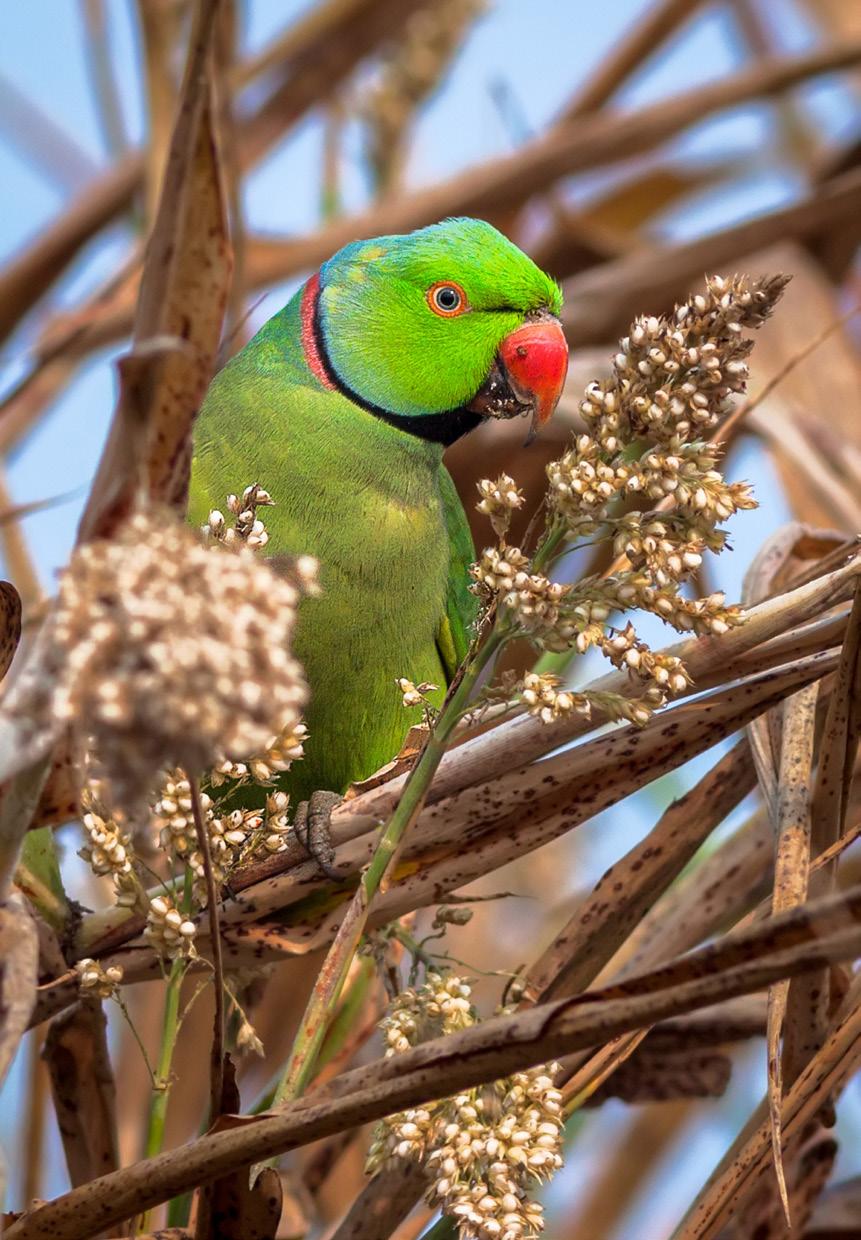
UPETDB is committed to – create policies that promote sustainable ecotourism that creates jobs and supports local culture and products (SDG target 8.9); and develop tools to monitor the sustainable development impacts of tourism (SDG target 12.b).
Our entire approach to ecotourism focuses on – creating jobs; supporting sustainable agriculture by providing supplies and production to hotels; promoting inclusiveness and empower women; preserving cultural and natural heritage; and reducing inequalities by engaging local populations and stakeholders in ecotourism related activities. ■
About The Authors
Dr. Rupak De is former Principal Chief Conservator of Forests, Uttar Pradesh India having more than 4 decades of experience in managing forests and wildlife in Uttar Pradesh. He headed Tiger National Park, Wildlife Sanctuaries and Lion Safari in Uttar Pradesh Presently he is helping organizations engaged in conservation and management of wildlife in India.
Dr. Rajiv Kumar Garg is former Principal Chief Conservator of Forests, Uttar Pradesh having more than 4 decades of experience in management of forests and wildlife in Uttar Pradesh. As Managing Director, Uttar Pradesh Forest Corporation he is entrusted with the responsibility of promotion of ecotourism in UP. Presently he is Senior Advisor, Tourism with iDeCK and assisting them in promotion of ecotourism in Uttar Pradesh.
Prakhar Misra is Director, Tourism and Additional Director, UP Eco tourism Development Board in Government of Uttar Pradesh. He is entrusted with the responsibility to oversee promotion of ecotourism all over Uttar Pradesh both in and outside forest and wildlife areas. Currently he is promoting ecotourism in partnership with host communities, private entities and government organizations.
Ananya Rai is a graduate from University of Delhi, India. She is a nature lover and wildlife enthusiast. Presently she is working as an intern with Department of Tourism, Government of Uttar Pradesh.
1. Bhabhar is a narrow belt of land in India that runs parallel to the Shiwalik Hills and is known for coarse materials like pebbles, gravel, and rocks
2. Terai is a belt of marshy land in India at the foot of the Himalayas in Northern India
3. Indo-Gangetic Plains (IGP) are one of the main food-producing regions of India. Encompassing the northern part of the Indian subcontinent, IGP region includes the Indian states of Punjab, Haryana, Uttar Pradesh, Bihar and West Bengal.
4. A deciduous forest is a forest where trees lose their leaves annually. These forests are characterized by broad-leaved trees, four seasons, and a temperate climate
5. Recorded forest area is the total geographical area recorded as forests in government records, regardless of the actual trees growing on the land. There can be some area recorded as forest but it might be a wasteland or wetland, similarly there can be forests on private lands and/or community lands which are not recorded as forests but provide same ecological functions.
6. A national park in India is a designated area of land protected by the government, set aside for the conservation of its natural flora and fauna, where human activities are strictly regulated to maintain the ecosystem in its most natural state, allowing for wildlife preservation and limited recreational activities like wildlife viewing and nature exploration.
7. A tiger reserve in India is a protected area that is designated to conserve the Bengal tiger, India’s national animal. A tiger reserve is a part of Project Tiger, an initiative launched in 1973 by the Government of India.
8. A wildlife sanctuary in India is a protected area that is reserved for the conservation of wildlife and their habitats. The purpose of a wildlife sanctuary is to provide safe environment for animals, especially those that are endangered or threatened. Restriction imposed in a wildlife sanctuary are less stringent as compared to national park.
9. A conservation reserve in India is a protected area that is designated to protect the landscape, seascape, flora, fauna, and their habitats.
10. A Ramsar site is a wetland area designated as being of international importance under the Ramsar Convention, an intergovernmental treaty focused on conserving and sustainably using wetlands. It’s a wetland recognized for its significant ecological value on a global scale, and is added to a list of “Wetlands of International Importance” when designated as a Ramsar site.
11. Terai Arc Landscape (TAL) is a 2.47-million-hectare biodiversity hotspot that spans across the Indian states of Uttarakhand, Uttar Pradesh, and Bihar, as well as the low-lying hills of Nepal. It’s made up of 14 protected areas in India and Nepal, and is home to a variety of flora and fauna. It is also home to more than 7.5 million people, and is critical for both human communities and wildlife. TAL is a globally important ecoregion, the Terai-Duar Savanna and Grasslands, which is characterized by savanna grasslands and evergreen and deciduous forest. TAL is extremely productive due to annual monsoon floods that deposit silt across the grasslands. TAL was recently named a World Restoration Flagship by the UN Decade on Ecosystem Restoration. This recognition is given to the best examples of ongoing, large-scale, and long-term ecosystem restoration.
12. A dhurrie is a traditional, flat-woven rug or carpet, typically handwoven, that is considered a staple in Indian households, often used as a floor covering, but can also serve as bedding or packaging due to its versatility and thin nature; it is known for its intricate designs and vibrant colors, often featuring geometric patterns and stripes, and is considered a symbol of Indian craftsmanship.
13. A mahout is a person who trains, rides, and cares for an elephant, essentially acting as an elephant keeper or handler; they are often from communities with generations of experience working with elephants, maintaining a close bond with their assigned animal throughout its working life.










